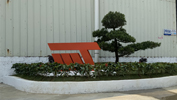Exploring Aluminum Building Material: Unveiling Its Impressive Heat Resistance
Author:Jayminton Time:2024-07-22

In the realm of modern construction, choosing the right building materials can significantly impact the performance, longevity, and sustainability of structures. Aluminum, renowned for its versatility and durability, stands out not only for its structural strength but also for its impressive heat resistance properties. Let’s delve into why aluminum is increasingly favored for its ability to withstand high temperatures and its applications in the construction industry.
Understanding Aluminum's Heat Resistance
Aluminum possesses remarkable heat resistance characteristics that make it a preferred choice in diverse architectural applications. Despite being lightweight, aluminum exhibits excellent thermal conductivity, allowing it to efficiently dissipate heat. This property is particularly advantageous in environments where temperature fluctuations are frequent or where thermal management is crucial for building occupants' comfort and energy efficiency.
Applications in High-Temperature Environments
One of the primary reasons aluminum is prized for its heat resistance is its ability to maintain structural integrity and performance under elevated temperatures. In architectural applications, such as curtain walls, roofing systems, and façades, aluminum effectively shields buildings from solar heat gain. This capability not only reduces the need for excessive cooling but also enhances the overall energy efficiency of the structure.
Fire Safety Considerations
Beyond its thermal conductivity, aluminum's inherent fire-resistant properties further enhance its appeal in construction. Aluminum does not burn, and in the event of a fire, it forms a protective oxide layer that insulates it from direct heat exposure. This characteristic significantly contributes to the fire safety standards of buildings, making aluminum a reliable choice for both residential and commercial developments.
Sustainability and Longevity
In addition to its heat resistance and fire safety attributes, aluminum is celebrated for its sustainability and longevity. As a fully recyclable material, aluminum supports green building practices by reducing environmental impact and promoting circular economy principles. Its durability ensures that structures built with aluminum maintain their performance and aesthetic appeal over extended periods, minimizing lifecycle costs and maintenance requirements.
Advancements in Aluminum Technology
Recent advancements in aluminum alloys and manufacturing processes have further enhanced its heat resistance capabilities. Engineers and architects now have access to high-performance aluminum alloys that offer superior strength and thermal management properties, expanding the design possibilities for energy-efficient and sustainable buildings.
Conclusion
In conclusion, aluminum's heat resistance makes it a cornerstone material in modern construction, offering architects and builders a versatile solution for enhancing building performance and safety. Its ability to withstand high temperatures, coupled with its sustainability and durability, underscores its relevance in meeting the evolving demands of the construction industry. Whether used in façades, roofing, or structural components, aluminum continues to prove its value as a reliable and innovative building material capable of shaping the future of architecture. Embrace the power of aluminum for your next project and experience firsthand its unmatched heat resistance and countless benefits.

 S1 Clip-in Metal ceiling System
S1 Clip-in Metal ceiling System JMT-L4.2 U-Baffle System
JMT-L4.2 U-Baffle System JMT Aluminum Wall Cladding
JMT Aluminum Wall Cladding Aluminum Honeycomb Panel
Aluminum Honeycomb Panel Air-Condenser Cover
Air-Condenser Cover Metal Heat Cover
Metal Heat Cover Singapore Changi Airport T2 Arrival
Singapore Changi Airport T2 Arrival Australia Marvrl Stadium City Edge
Australia Marvrl Stadium City Edge Enterprise Information Announcement
Enterprise Information Announcement Construction Industry Solutions
Construction Industry Solutions About Jayminton
About Jayminton Contact US
Contact US